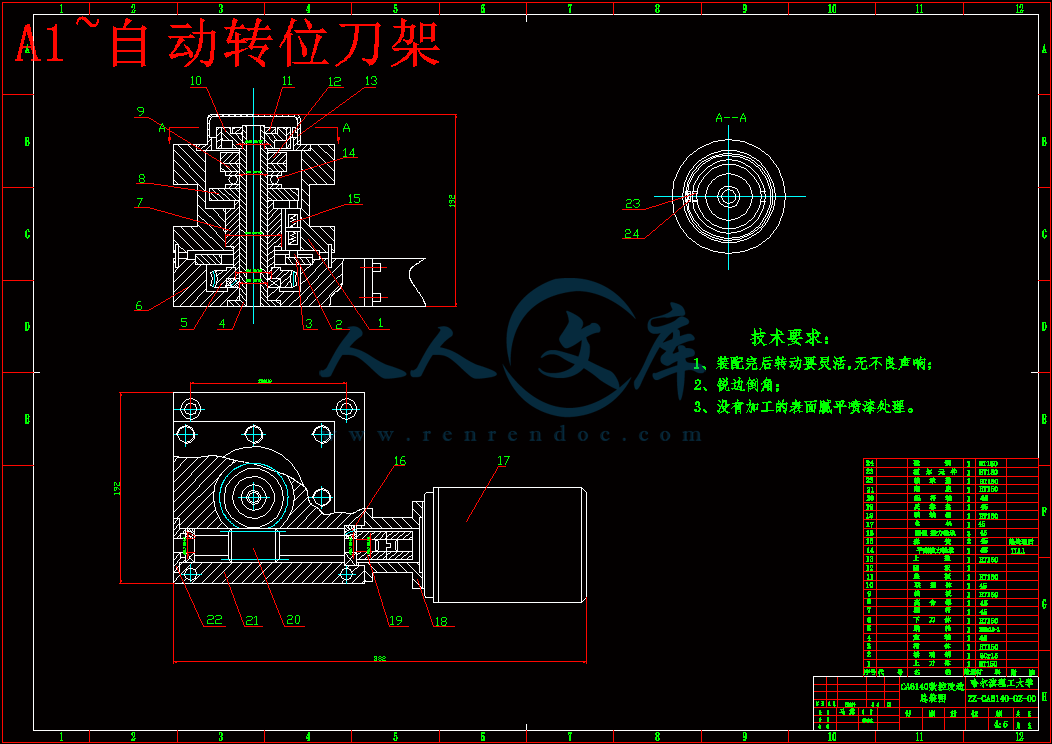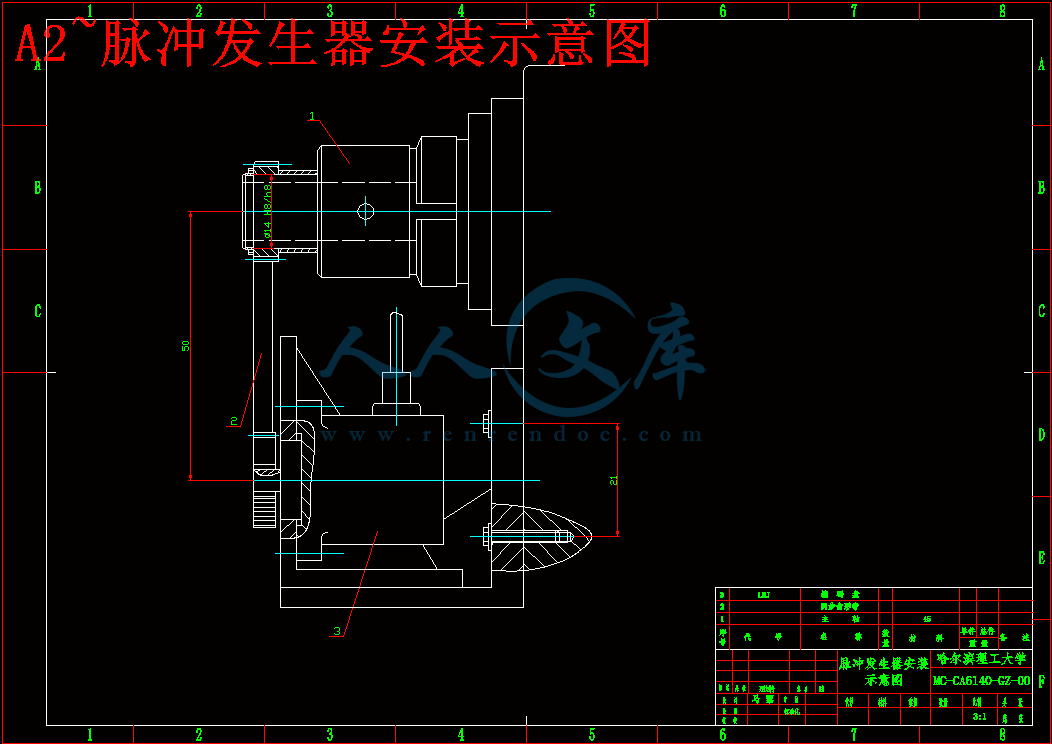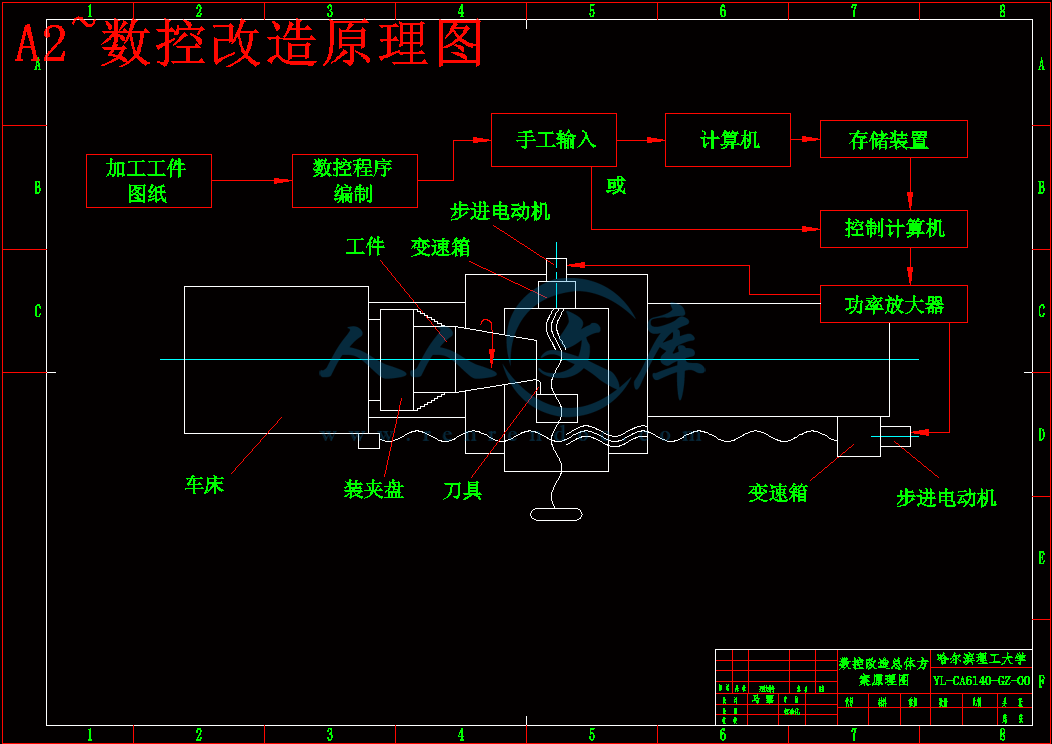C6140车床数控改造设计
34页 13000字数+说明书+任务书+外文翻译+8张CAD图纸【详情如下】
A1~横向进给机构示意图.dwg
A1~纵向进给机构示意图.dwg
A1~自动转位刀架.dwg
A2~CA6140数控改造总装图.dwg
A2~LBJ光电编码盘.dwg
A2~数控改造原理图.dwg
A2~脉冲发生器安装示意图.dwg
A3~齿轮零件图.dwg
C6140车床数控改造设计论文.doc
任务书.doc
外文翻译--数控机床.doc
01- 评语.doc
C6140数控机床改造
摘 要
由于目前国内的数控机床数量需求量大,达到300万台之巨,要进行全部翻新在实践,物质尚不具有足够的条件,为了达到的条件,为达到较高的精度,实现较好的经济性,对普通车床实行数控开环改造。
了解数控机床的概念,所谓数字控制是按照含有机床(刀具)运动信息程序所指定的顺序自动执行操作的过程。而计算机数控机床就是数控机床在计算机监控下进行工作。它的优点很多,可以在同一机床上一次装夹可完成多个操作,生产率显著提高等优点,但它的价格昂贵。由于我国现在使用的机床大多数为普通车床,自动化程度低,要更新现有机床需要很多资金。为了解决这个问题,也为了适应多品种中、小批量零件加工我们选择机床经济型数控改造。本次设计主要为纵向进给系统的设计,其中包括纵向进给系统改造方案的确定,各零部件的设计。
关键词 数控;车床;改造;
C6140 ordinary lathe of numerical control technology transformation
Abstract
Due to the current number of domestic CNC machine tool demand to reach300 million units of the giant,to be totally refurbished at the time, the material is not yet sufficient condition,in order to achieve the conditions to achieve high accuracy to achieve better economic nature of the open-loop CNC lathe to implement reform.Understand the concept of CNC machine tools,in accordance with the so-called digital control machine tools(tool)motion information in the order specified by the program automatically performs the operation.CNC machine tool sand CNC machine tools is to work under the supervision of the computer.It has many advantages,can be a fixture on the same machine can perform multiple operations,significantly improve productivity, etc., but it's expensive.Since China is now mostly used lathe machine,low degree of automation, to update existing machines need a lot of money.To solve this problem, but also to adapt to many varieties,small batch machining parts we choose economical CNC machine tools transformation.This design is mainly vertical feed system design, including vertical feed system transformation program to determine various parts of the design.
Keywords NC; lathe; transform;
目录
摘要I
AbstractII
第1章 绪 论1
1.1 课题背景1
1.1.1 国内数控机床现状1
1.1.2 国内数控机床的特点1
1.2 数控机床发展概况2
1.2.1 继续向开放式、基于PC的第六代方向发展2
1.2.2 向高速化和高精度化发展2
1.2.3 向智能化方向发展2
1.3 机床数控化改造的必要性2
1.3.1 微观看改造的必要性2
1.3.2 宏观看改造的必要性3
1.4 数控化改造的市场空间3
1.4.1 国内的市场3
1.4.2 进口设备和生产线的数控化改造市场4
1.5 机床改造的效益分析4
第2章 普通车床的数控改造和可行性论证6
2.1 车床的数控改造6
2.1.1 设计内容及任务6
2.1.2 数控机床工作原理及组成6
2.2 可行性论证7
第3章 总体方案的拟定和论证8
3.1 总体方案的拟定8
3.2 控制方式类型选择9
3.3 伺服进给机构的改造10
3.3.1 纵向进给机构的改造10
3.3.2 横向进给机构的改造10
3.3.3 步进电动机的选用10
3.3.4 丝杠螺母副10
3.3.5 机床导轨改造10
3.4 总体设计方案的确定11
第4章 伺服进给机构设计12
4.1 伺服系统的组成原理12
4.2 伺服进给机构的设计内容和设计计算12
4.2.1 纵向进给系统的设计计算13
4.2.2 横向进给系统的设计计算17
4.3 步进电机的选择20
4.3.1 C6140纵向进给系统步进电机确定20
4.3.2 C6140横向进给系统步进电机的确定20
4.4 伺服系统说明21
4.4.1 机床进给系统的结构及工作原理21
第5章 自动转位刀架22
5.1 数控车床刀架的基本要求22
5.2 数控车床刀架结构22
5.3 工作原理23
5.4 刀架的安装24
第6章 编码盘的安装部分25
6.1 光电编码器工作原理25
6.2 编码盘的安装25
结论27
致谢28
参考文献29
附录30
绪 论
课题背景
1946年诞生了世界上第一台电子计算机,这表明人类创造了可增强和部分代替脑力劳动的工具。它与人类在农业、工业社会中创造的那些只是增强体力劳动的工具相比,起了质的飞跃,为人类进入信息社会奠定了基础。6年后,即在1952年,计算机技术应用到了机床上,在美国诞生了第一台数控机床。从此,传统机床产生了质的变化。近半个世纪以来,数控系统经历了两个阶段和六代的发展。
国内数控机床现状
近年来我国企业的数控机床占有率逐年上升,在大中企业已有较多的使用,在中小企业甚至个体企业中也普遍开始使用。在这些数控机床中,除少量机床以FMS模式集成使用外,大都处于单机运行状态,并且相当部分处于使用效率不高,管理方式落后的状态。?2001年,我国机床工业产值已进入世界第5名,机床消费额在世界排名上升到第3位,达47.39亿美元,仅次于美国的53.67亿美元,消费额比上一年增长25%。但由于国产数控机床不能满足市场的需求,使我国机床的进口额呈逐年上升态势,2001年进口机床跃升至世界第2位,达24.06亿美元,比上年增长27.3%。?近年来我国出口额增幅较大的数控机床有数控车床、数控磨床、数控特种加工机床、数控剪板机、数控成形折弯机、数控压铸机等,普通机床有钻床、锯床、插床、拉床、组合机床、液压压力机、木工机床等。出口的数控机床品种以中低档为主
国内数控机床的特点
新产品开发有了很大突破,技术含量高的产品占据主导地位。
数控机床产量大幅度增长,数控化率显著提高。2001年国内数控金切机床产量已达1.8万台,比上年增长28.5%。金切机床行业产值数控化率 从2000年的17.4%提高到2001年的22.7%。
控机床发展的关键配套产品有了突破。微观看改造的必要性
从微观上看,数控机床比传统机床有以下突出的优越性,而且这些优越性均来自数控系统所包含的计算机的威力。
可以加工出传统机床加工不出来的曲线、曲面等复杂的零件。由于计算机有高超的运算能力,可以瞬时准确地计算出每个坐标轴瞬时应该运动的运动量,因此可以复合成复杂的曲线或曲面。
可以实现加工的自动化,而且是柔性自动化,从而效率可比传统机床提高3~7倍。由于计算机有记忆和存储能力,可以将输入的程序记住和存储下来,然后按程序规定的顺序自动去执行,从而实现自动化。数控机床只要更换一个程序,就可实现另一工件加工的自动化,从而使单件和小批生产得以自动化,故被称为实现了"柔性自动化"。
加工零件的精度高,尺寸分散度小,使装配容易不再需要"修配"。
可实现多工序的集中,减少零件 在机床间的频繁搬运。
拥有自动报警、自动监控、自动补偿等多种自律功能,因而可实现长时间无人看管加工。
由以上五条派生的好处。
如:降低了工人的劳动强度,节省了劳动力(一个人可以看管多台机床),减少了工装,缩短了新产品试制周期和生产周期,可对市场需求作出快速反应等等。
宏观看改造的必要性
从宏观上看,工业发达国家的军、民机械工业,在70年代末、80年代初已开始大规模应用数控机床。由于采用信息技术对国外军、民机械工业进行深入改造(称之为信息化),最终使得他们的产品在国际军品和民品的市场上竞争力大为增强。而我们在信息技术改造传统产业方面比发达国家约落后20年。如我国机床拥有量中,数控机床的比重(数控化率)到1995年只有1.9%,而日本在1994年已达20.8%,因此每年都有大量机电产品进口。这也就从宏观上说明了机床数控化改造的必要性。
数控化改造的市场空间
机床的数控制化改造是一个方兴未的行业,从各种统计数字上看前途应该是十分光明的,例如:"在美国,日本和德国等发达国家,它们的机床改造人作为新的经济增长行业,生意盎然,正处在黄金时代。由于机床以及数控技术的不断进步,机床改造是一个"永恒"的课题。我国的机床改造业,也从老的行业进入到以数控技术为主的新的行业所以不难看出:
国内的市场
我国目前机床总量380余万台,而其中数控机床总数只有11.34万台,即我国机床数控化率不到3%。近10年来,我国数控机床年产量约为0.6~0.8万台,年产值约为18亿元。机床的年产量数控化率为6%。我国机床役龄10年以上的占60%以上;10年以下的机床中,自动/半自动机床不到20%,FMC/FMS等自动化生产线更屈指可数(美国和日本自动和半自动机床占60%以上)。可见我们的大多数制造行业和企业的生产、加工装备绝大数是传统的机床,而且半数以上是役龄在10年以上的旧机床。用这种装备加工出来的产品普遍存在质量差、品种少、档次低、成本高、供货期长,从而在国际、国内市场上缺乏竞争力,直接影响一个企业的产品、市场、效益,影响企业的生存和发展。所以必须大力提高机床的数控化率。
进口设备和生产线的数控化改造市场
我国自改革开放以来,很多企业从国外引进技术、设备和生产线进行技术改造。据不完全统计,从1979~1988年10年间,全国引进技术改造项目就有18446项,大约165.8亿美元。 这些项目中,大部分项目为我国的经济建设发挥了应有的作用。但是有的引进项目由于种种原因,设备或生产线不能正常运转,甚至瘫痪,使企业的效益受到影响,严重的使企业陷入困境。一些设备、生产线从国外引进以后,有的消化吸收不好,备件不全,维护不当,结果运转不良;有的引进时只注意引进设备、仪器、生产线,忽视软件、工艺、管理等,造成项目不完整,设备潜力不能发挥;有的甚至不能启动运行,没有发挥应有的作用;有的生产线的产品销路很好,但是因为设备故障不能达产达标;有的因为能耗高、产品合格率低而造成亏损;有的已引进较长时间,需要进行技术更新。种种原因使有的设备不仅没有创造财富,反而消耗着财富。 这些不能使用的设备、生产线是个包袱,也是一批很大的存量资产,修好了就是财富。只要找出主要的技术难点,解决关键技术问题,就可以最小的投资盘活最大的存量资产,争取到最大的经济效益和社会效益。这也是一个极大的改造市场。 提高机床数控化效率有两个途径:一是购买新的数控机床;二是对旧的机床进行改造而对于一个机床拥有量大,经济财力又不足的发展中国家来说,采用旧机床改造来提高设备的先进性和数控化率是一个极其有效和使用的途径,采用第二中方法有以下的优点:
减少了投资和交货的期限,同购置新的数控机床相比,一般可以节省60%到80%的费用,改造的费用大大减低。
机械的稳定性可靠机床的床身,立柱等基础件都是重而坚固的铸铁构件,而铸件越久自然失效充分,内应力的消除使得比新的铸件更稳定,这些铸件的使用又可以节约社会资源,又减少了铸铁件生产时对环境的污染。
熟悉了解设备结构性能,便于操作维修购买的新设备,事先很难前面了解机床的结构性能,以至很难预算是否完全适合加工要求,而改造则完全可以避免这种情况,并且大大缩短了对数控机床在使用和维修方面的培训时间,机床一旦改装完成,很快就可以投入使用,见效较快。
可以充分利用现有的条件,可以充分利用现有的地基,不必像购新机时重新构筑新基,同时工夹具、样板和外设备也可以在利用。
可更好的因地制宜合理筛选功能,购买现成的通用型机床,往往对一个具体的生产加工有一些多余的功能,又可能缺少某一个专用的特殊功能,如向机床制造厂提出特殊定货要求,增加某些特殊的加工要求,往往费用大,交货的日期又长。而采用改造的方案就可以根据生产加工要求,采用组合的方法再某些部件设计改造成专用的数控机床。
可及时采用最新技术,充分利用社会资源,由于技术进步和我国机床功能部件专业化生产的发展,目前已有众多的疏忽资源支持机床方面的改造 ,如随意采购各种尺寸的滚珠丝杠副,且交货期短;采用贴塑导轨新技术,可使传统的滑动导轨的摩擦系数降低五至十几倍来防止爬行,还可以使得刮研极容易,等等例子说明有一大批社会资源,可根据技术更新的发展速度,及时地采用最新技术来提高生产设备的自动化水平和效率,提高设备质量和档次,将旧机场改造成当今水平的机床。普通车床的数控改造和可行性论证
车床的数控改造
设计内容及任务
普通车床()的数控改造设计内容包括:总体方案的确定和验证、机械改造部分的设计计算(伺服进给机构设计、自动转位刀架的选择或设计、编码盘安装部分的结构设计)、主运动自动变速原理、部分系统控制软件设计。
本设计任务是对卧式车床进行数控化改造,实现微机对车床的数控化控制。利用微机对车床的纵向、横向进给系统进行数字控制,并要达到纵向最小运动单位为0.01/脉冲,横向最小运动单位0.005/脉冲,主运动要实现自动变速,刀架要改造成自动控制的自动转位刀架,要能自动的切削螺纹。
数控机床工作原理及组成
数控机床工作原理:
数控机床加工零件时,首先应编制零件的加工程序,这是数控机床的工作指令。将加工程序输入到数控装置,再由数控装置控制机床主运动的变化、起停,进给运动的方向、速度和位移量以及其它如刀具选择交换、工件夹紧松开和冷却润滑的开、关等动作,使刀具与工件及其它辅助装置严格的按照加工程序规定的顺序、轨迹和参数进行工作,从而加工出符合要求的零件。
数控机床的组成:
数控机床主要由控制介质、数控装置、伺服系统和机床本体等四部分组成,其组成框图如图2-1
图2-1数控机床的组成图
可行性论证
根据《自动化制造系统》,可行性论证使用户建造自动化制造系统项目前所进行的技术和经济性分析报告,是上级主管部门审定和批准立项的基本依据。同样,在进行普通车床的经济型数控改造之前进行合理的、科学的可行性论证是必要的。
根据传统的论证方法,普通车床的经济型数控改造的可行性论证应围绕以下几个方面进行,即企业生产经营现状及存在的问题分析,企业生产经营目标,改造的基础条件、目标、技术方案、投资概算、效益分析,改造后车床的实施计划,结论等。
由于本设计仅作为大学本科生的毕业设计,故在此,设计者仅对改造的投资概算作一简要的可行性论证。
本改造设计是对普通车床C1640进行经济型数控改造。在改造设计中,采用的是广州数控设备厂生产的GSK980T型数控系统,加上两台伺服电机,费用约为4万余元;两套滚珠丝杠副和相配的传动部分以及齿轮副、贴塑导轨等零件,费用约为1万余元,总的改造费用约为5~6万元。旧车床估计截至在6~7万元。这样设备改造费用和旧设备费用总计不会超过13万元。因此,对普通车床作经济型数控改造适合我国国情,是国内企业提高车床的自动化能力和精密程度的有效选择。它具有一定的典型性和实用性。 C6140车床主要用于对中小型轴类、盘类以及螺纹零件的加工,这些零件加工工艺要求机床应完成的工作内容有:控制主轴正反转和实现其不同切削速度的主轴变速;刀架能实现纵向和横向的进给运动,并具备在换刀点自动改变四个刀位完成选择刀具;冷却泵、润滑泵的启停;加工螺纹时,应保证主轴转一转,刀架移动一个被加工螺纹的螺距或导程。这些工作内容,就是数控化改造数控系统控制的对象。察看C616车床及有关资料,并且参照数控车床的改造经验,确定总体改造方案。
主传动系统的设计改造
对普通车床进行数控改造时,一般可保留原有的主传动系统和变速操作机构,以减少改造量。但本设计中为了提高车床的自动化程度,以便于在加工过程中实现自动变换切削速度,对其作了相应的简化改造。
采用交流调速电机做车床主轴电机以取代原来的主轴电机,以实现无级调速;并简化原来传动系统,以达到多档调速范围的确定。
数控系统的选择设计
计算机数控装置(CNC)即控制装置是数控机床的中心环节。它通过对加工程序的运行处理,发出控制信号,实现对加工过程的自动控制。
在本设计中,由于时间较短、设计人员少,因而我们决定引进江苏东方数控新技术公司生产的NIM-9702数控系统。
自动转为到家选择设计
数控机床的刀架是机床的重要组成部分。其结构直接影响车床的切削性能和效率。卧式车床数控改造应将原来机床的普通手动转位刀架替换成自动换位刀架,本设计决定采用常州武进数控设备厂生产的LD4四工位螺旋转位刀架。
驱动系统的设计改造
由于改造设计的是简易型经济数控,所以在考虑具体方案时,基本原则是在满足需要的前提下,对于机床尽可能减小改动量,以降低成本。总体改造如下图3-1所示:
参 考 文 献
张新义主编.经济型数控机床系统设计.机械工业出版社,1998:120~125
余英良主编.机床数控改造设计与实例.机械工业出版社,1994:40~47
孙桓等主编.机械原理,高等教育出版社,1995
王贵明主编.数控实用技术,机械工业出版社,2001:12~15
张建纲、胡大锋主编.数控技术.华中科技大学出版社,2000:15~22
张建明主编.机电一体华系统控制.高等教育出版社,2001:135~140
邓星钟主编.机电传动控制.华中科技大学出版社,2001:77~80
王爱玲主编.现代数控机床结构与设计.兵器工业出版,1997:223~280
卜云峰主编.机械工业及自动化简明设计手册上下册.机械工业出版社,1999:200~247
李洪主编.实用机床设计手册.辽宁科学技术出版社,1999:155~173
陶晓杰主编. 伺服电机用于车床进给系统.制造业自动化,2004:20~158
机床设计手册编写组. 机床设计手册(第三册). 机械工业出版社 ,1986:65~95
English for Numerical Control Technology.高等教育出版社,2009
John L.Feirer.Machine Tool Metalworking.1973








 川公网安备: 51019002004831号
川公网安备: 51019002004831号